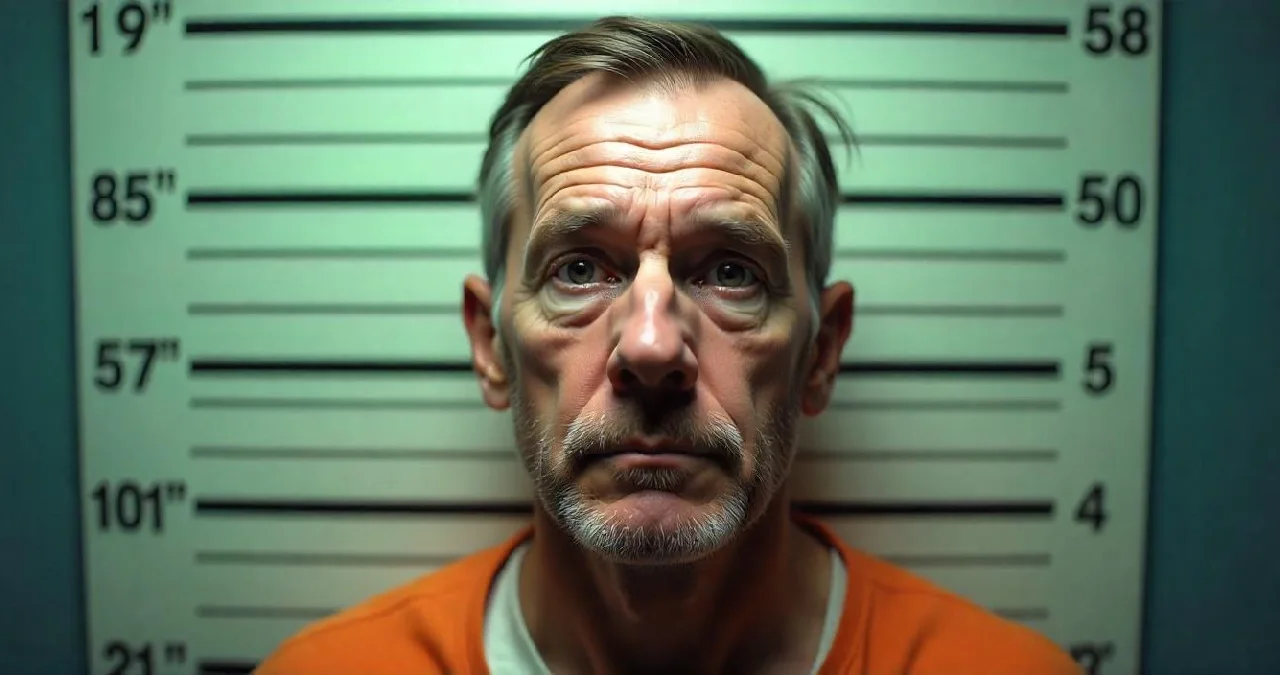How often does a singular image capture the complexities of the legal and societal issues surrounding crime? The mugshot of Dennis Eugene Durden serves as both an artifact and a dialogue starter, prompting discussions that stretch beyond the confines of its frame. Its existence speaks to questions of identity and the machine-like precision of law enforcement processes.
His mugshot is not merely a static image but part of a larger narrative involving crime, accountability, and transparency. At the core, you decipher years of coded history, where the image acts as both a record and a silent witness to the veracity of the events that unfolded. It embodies a moment in time captured by the intricate machinery of the justice system, offering experts a lens into the complexities of crime-related imagery.
Dennis Eugene Durden Mugshot: More Than an Image
The mugshot of Dennis Eugene Durden represents more than just a photograph. It captures a moment in time tied to crime and justice. Many people look at mugshots expecting a simple image, but they see stories. Each face, each detail holds a piece of a bigger story. These photos give insight into a person’s life at a critical juncture.
Mugshots serve various purposes in the realm of law enforcement. Beyond their immediate use for identification, they influence public opinion and feed into larger narratives. They help in building stories around crime and its societal impact. But not many ponder what story each mugshot tells. They are powerful in shaping how the world views crime and the people linked to it.
A mugshot’s role extends beyond the immediate crime case. It is used in criminal databases and sometimes finds its way into media outlets. This makes it not just a tool for justice but also a part of public perception. How the media portrays these images can change how people understand crime and punishment. It portrays individuals in a light that sticks with them, affecting reputation and privacy.
It’s vital to think about what Dennis Eugene Durden’s mugshot signifies today. It’s not just about the person but the larger issues of legal processes and societal perceptions. By looking at these images, we consider our ideas about crime and justice. The image offers us a chance to question and examine our views on right and wrong. As society grapples with how powerful mugshots can be, we take a closer look at what they truly mean.
The Power and Influence of Mugshots in Crime Perception
Mugshots are powerful images that shape how we see crime and criminals. Often, they are the first thing people see when news of an arrest breaks. They create an immediate impression of guilt or innocence. They can impact jury perceptions and even affect how the public responds to a case. The key is in how the mugshot is presented and understood.
The media plays a crucial role in amplifying the impact of mugshots. When these images are splashed across news outlets, they can sway public opinion. For some, a mugshot may evoke sympathy or disdain. Others might see them as convincing evidence that a person is involved in wrongdoing. It’s essential to realize how these images can manipulate perceptions.
Mugshots serve not just as identification but as a tool in storytelling. They humanize police reports, attaching a face to the actions described. They make crime feel more real and immediate to those watching the news. This has both positive and negative outcomes. On one hand, it raises awareness; on the other, it can prematurely judge someone’s character.
This presents a challenging question: how do we perceive those captured in mugshots? The influence of a simple image can be profound, affecting the lives of those pictured. It reminds us to critically engage with what we see. Recognizing the power behind a mugshot means understanding it’s more than just a photo. It’s a representation of how society views justice and fairness.
The Historical Context Behind Mugshots
Mugshots have a rich history dating back to the 19th century. They became a key tool in law enforcement as police departments sought ways to improve criminal identification. Before mugshots, identifying suspects relied on written descriptions and witness testimonies. This method often led to mistakes. Introducing a photographic record marked a significant step forward.
The concept of mugshots emerged from the need for a reliable police system. Alphonse Bertillon, a French police officer, developed the system in the late 1800s. His method included standardized photography operations to ensure consistent image quality. He believed that photographing criminals would help in tracking repeat offenders. His practices influenced how police forces around the world began to operate.
In addition to photos, Bertillon’s system combined physical measurements. Capturing these details helped create a more comprehensive profile of the suspect. Over time, the process evolved from plain photos to full data profiles. This made it easier to organize and search for information. Technology enhanced these tools, further perfecting the identification process.
Now, mugshots are a standard part of the justice system. They continue to evolve as digital technologies change how records are kept and shared. This history shows how initial ideas shaped today’s tools in legal systems. Viewing mugshots within their historical context, we see their importance. They reflect the ever-changing landscape of legal and social orders.
Reading Beyond the Image: The Story of Dennis Eugene Durden
The mugshot of Dennis Eugene Durden is more than just an image; it is a fragmented chapter of his life. When you see a mugshot, numerous questions arise about the person behind the photograph. What circumstances led to this moment? The story isn’t always clear, but the image triggers a curiosity to know more. This curiosity can be both positive and negative in shaping public perception.
Durden’s image can be viewed as a symbol of a larger narrative. For some, it evokes thoughts about crime and punishment. For others, it’s a reminder of the complex personal stories that often get lost behind the headlines. Each person’s tale can hold lessons about accountability, choices, and consequences. It invites analysis of the social factors that may have influenced his path.
Looking further into Durden’s backstory, you might find varied aspects that reveal more than what a single image can show. There may be missed opportunities, societal pressures, or personal challenges that aren’t immediately visible. It’s important to dig deeper and seek those hidden layers. By doing so, you gather more comprehensive insights into both the person and the larger societal issues. The mugshot is just the beginning of this exploration.
Furthermore, the impact of such imagery reflects how society processes events like arrests and legal actions. When a mugshot circulates, it influences public reaction and potentially affects the person involved. It’s worthwhile to consider how these images impact lives long after they first appear. The conversation around mugshots should include their long-term effects on individuals and communities.
The story of Dennis Eugene Durden extends beyond the photograph, urging us to reflect on the intricate weave of personal history and societal influences. It’s a call to look beyond surface appearances and engage with deeper narratives. By doing so, you nurture a broader understanding of justice and humanity. Mugshots, while significant, cannot provide all the answers. They open the door for further exploration and comprehension.
The Role of Mugshots in Legal Proceedings
Mugshots play a crucial role in legal proceedings, serving as initial identifiers for individuals involved in the justice system. These photographs document suspects at the point of arrest, creating a visual record. Law enforcement uses them to verify identity and maintain accurate records. This practice assists in preventing mistaken identity in legal cases. The presence of a mugshot can streamline proceedings by clarifying identities.
In courtrooms, mugshots may be presented as evidence to support various claims. However, their impact varies based on how they are introduced within a case. While they can help in confirming someone’s presence at an arrest, caution surrounds their use due to potential bias. Bringing a face to a name can influence juries, consciously or subconsciously. This raises questions about fairness and objectivity, urging careful consideration.
Information from mugshots helps update criminal databases. They provide police and court systems with an efficient way to organize and access information. This facilitates background checks and future investigations. With digital technologies, mugshots are now easier to share between agencies. This quick access can be pivotal in solving crimes or preventing evasion.
Despite their utility, mugshots generate ongoing debate about privacy and ethics. Once taken, these images often become public, affecting personal and professional lives. The accessibility of mugshots online means they can be viewed far beyond legal circles. This exposure challenges the balance between public right-to-know and personal privacy. It is a topic courts continue to navigate in this digital age.
Overall, mugshots have an enduring presence in the legal sphere. Their role is multi-faceted, touching on identification, evidence, and public perception. Understanding their function helps in questioning how justice is served. It’s crucial to weigh the benefits and challenges they present. As technology advances, the conversation about their use continues to evolve.
The Ethical Considerations Surrounding Public Display of Mugshots
The public display of mugshots raises important ethical concerns, especially regarding privacy. These photos become easily accessible online, often without the consent of those pictured. When mugshots are shared, individuals face scrutiny and stigma, impacting their lives. These images can become a lifelong label, affecting jobs and relationships. This raises questions about the rights of individuals versus public awareness.
Another ethical issue lies in the presumption of innocence. Mugshots are taken at the time of arrest, not conviction, which can mislead the public. People often assume guilt based solely on these images. This negatively impacts those who may later be found innocent. As such, the process might seem unfair and biased from the start.
Some argue that the availability of these images helps in transparency and public safety. Knowing who has been arrested can inform community awareness. However, the way these images are used often harms more than helps. Sometimes, media outlets and websites use them solely for sensationalism or profit. This practice turns private struggles into public spectacles.
Society must consider alternatives to the open sharing of mugshots. One idea involves limiting their release to actual criminal justice needs. By restricting public access, privacy concerns could be better managed. Some suggest removing mugshots from public databases after case resolutions. This helps balance the line between openness and protecting individual rights.
Ultimately, ethical considerations demand careful thought and action. The discussion about the public display of mugshots revolves around fairness, justice, and respect. As the digital age progresses, the conversation only grows more significant. Balancing ethics with public interest remains a critical challenge. Addressing this issue requires ongoing dialogue and adaptable solutions.
Final Reflections on Mugshots and Their Influence
Mugshots like the one of Dennis Eugene Durden offer more than simple identification; they hold significant social and legal weight. Engaging with these images encourages you to consider broader implications about justice and perception. As you analyze these facets, it’s crucial to address the balance between public safety and individual rights.
Your exploration of mugshots raises vital questions about privacy, bias, and media influence within the justice system. Each mugshot tells a story with layers waiting to be uncovered, reflecting larger societal themes. Continuing this conversation leads to more informed perspectives and potential solutions for ethical dilemmas in public and legal domains.


admin